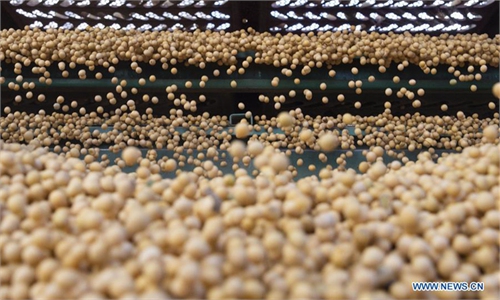
Aerial photo taken on May 11, 2022 shows farmers operating machines to sow soybean seeds in Fanhe Township of Tieling, northeast China's Liaoning Province. Liaoning has stepped up efforts on farming activities as the temperature rises recently. By May 17, the province's spring sowing area of crops has reached 48,645,000 mu (3,243,000 hectares).(Photo: Xinhua)
China may import less corn and soybean this year, agricultural experts said on Tuesday, after US corn futures price hit a 2-month high as drought is expected to cut into crop yields.Chicago Board of Trade corn futures price recorded a two-month high on Monday at $6.83 a bushel, and wheat futures price reached an August high of $8.4275. But soybean futures slid to $14.3775 later as the crop has been less affected by the dry and hot weather.
"US feed grain production in 2022 is forecast to be 6.3 million tons lower this month, reflecting lower yields in corn, sorghum, and barley. US corn production is lowered 146 million bushels on a 1.6 bushel per acre yield drop to 175.4 bushels," read a market outlook by the US Department of Agriculture (USDA) updated on August 16.
As for soybeans, though the USDA gave an optimistic forecast and raised the 2022/23 soybean production estimate by 25.56 million bushels to 4.53 billion, there were also market reports telling a less promising outlook, citing lower crop yields in major production bases.
The Northern Hemisphere has experienced prolonged high temperatures this summer, which affected harvest, including corn and soybeans, and would push up market prices.
Under these circumstances, China's corn imports is forecast to decrease in 2022, while its soybean imports may stay relatively stable, Li Guoxiang, a research fellow at the Chinese Academy of Social Sciences, told the Global Times on Tuesday.
China's corn imports in 2021 hit a new record of 28.35 million tons, up 152 percent year-on-year, according to data from the General Administration of Customs.
However, the overall impact on China's grain imports will be limited, Jiao Shanwei, editor-in-chief of industry news website cngrain.com, told the Global Times.
Jiao said there is some hype behind the surging corn prices. It's now a crucial period for the growth of autumn crops, when weather could easily be reflected in the futures market. The exact scale of crop losses remains to be seen, he said.
China has been diversifying its grain suppliers in recent years, especially involving countries and regions under the Belt and Road Initiative. China has been adjusting supplies across different crop varieties and also offering additional supplies to the market. A small import decrease won't have much impact on domestic grain market, Jiao noted.
China imported 54.17 million tons of soybeans in the first seven months, down 5.9 percent year-on-year, and corn imports fell 16.7 percent year-on-year to 15.13 million tons, customs data showed.



